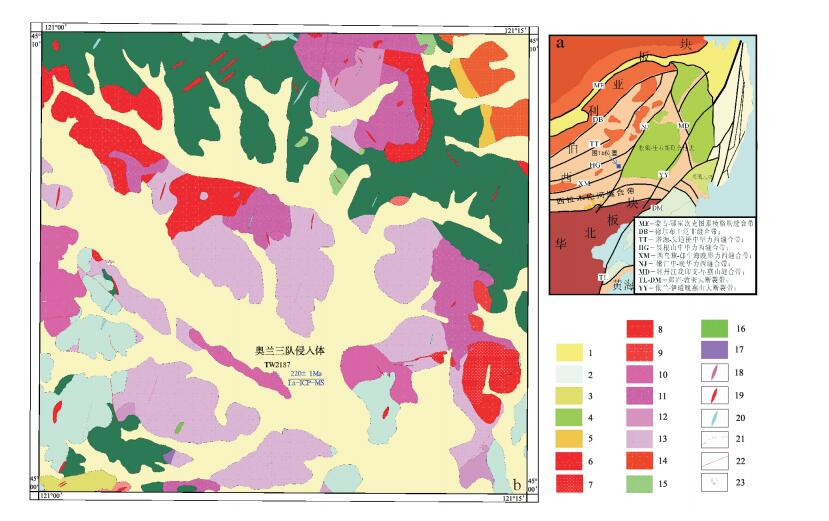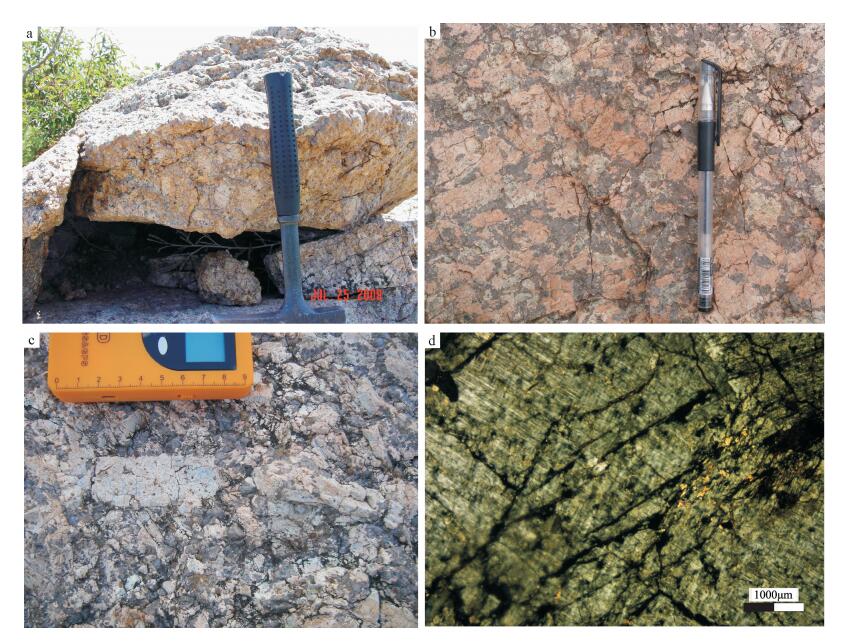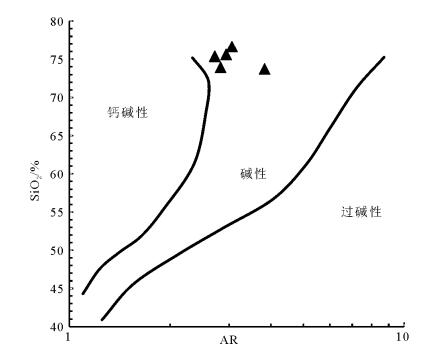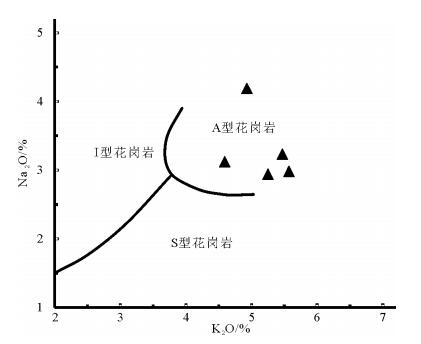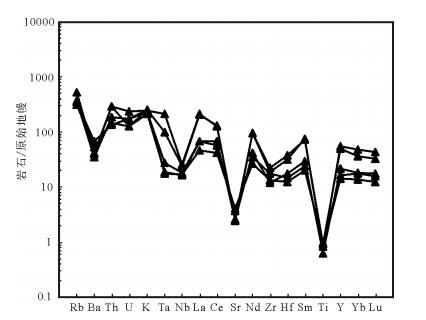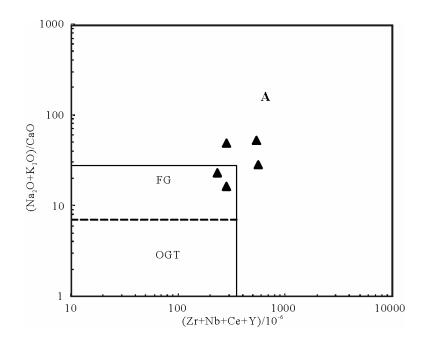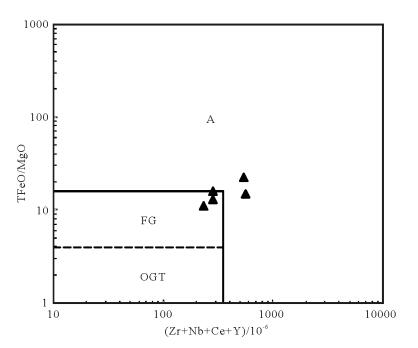Geochronology and geochemistry of the Aolansandui pluton in Horqin Right Wing Middle Banner of Inner Mongolia
-
摘要:
内蒙古科尔沁右翼中旗敖兰三队侵入体的同位素年代学及岩石地球化学研究表明, 敖兰三队侵入体巨晶正长花岗岩具有低Sr、高Yb型花岗岩特征, 其LA-ICP-MS锆石206Pb/238U年龄加权平均值为220±1Ma, 表明该侵入体是晚三叠世早期侵位形成的。岩石高硅、富碱、高铁镁比、贫钙、贫镁和低钛; 稀土元素配分曲线呈现"海鸥式"分布特征, 显示强烈的Eu负异常。微量元素特征显示较低的Sr、Ba含量, 较高的Yb、Zr和Y含量, 在微量元素原始地幔标准化蛛网图上显示明显的Sr、Ba和Ti的负异常。岩石具有高的Rb/Sr和Rb/Nb, 显示出壳源岩浆的成分特征。综合分析表明, 本区巨晶正长花岗岩为低压下地壳部分熔融的产物。根据(Y+Nb)-Rb、(Yb+Ta)-Rb、Nb-Y-Ce三角图解, 并结合区域构造演化, 认为巨晶正长花岗岩形成于造山后伸展的构造环境。在中-晚三叠世, 内蒙古科尔沁右翼中旗地区构造体制经历了重要的转变, 由挤压体制转变为造山后软流圈上涌、岩石圈减薄。
-
关键词:
- 科尔沁右翼中旗 /
- 敖兰三队侵入体 /
- 晚三叠世 /
- 低Sr高Yb型花岗岩
Abstract:Geochronology and geochemistry of the Aolansandui pluton in Horqin Right Wing Middle Banner of Inner Mongolia were studied. Zircon U-Pb dating demonstrates that the weighted mean 206Pb/238U age for the zircons from the syenogranite is 220±1Ma, suggesting Late Triassic. The syenogranite belongs to low-Sr and high-Yb type granitoids. The syenogranite is characterized by high SiO2, high alkali, high TFeO/MgO ratios, and low CaO, low MgO and lower TiO2 values. The syenogranite is characterized by "sea-gull" REE patterns and significant negative Eu anomaly as well as depletion of Sr and Ba and enrichment of Yb, Zr and Y. The high Rb/Sr and Rb/Nb ratios of the rock indicate a crustal origin. Comprehensive analysis shows that the syenitegranite was formed by low pressure felsic crust partial melting. In (Y+Nb)-Rb, (Yb+Ta)-Rb, Nb-Y-Ce diagrams combined with regional tec-tonic evolution, the authors hold that the syenogranite was formed in a post-orogenic setting. In the Middle Late Triassic period, the regional tectonic regime in Horqin Right Wing Middle Banner of Inner Mongolia underwent significant changes, and experienced as-thenosphere upwelling after squeezing into the orogenic lithosphere and thinning.
-
大兴安岭北段具有多阶段、多构造域叠加的演化特征,从古亚洲洋构造域额尔古纳地块的演化到蒙古-鄂霍茨克构造域的影响,以及古太平洋构造域的叠加改造(图 1-a)。而大兴安岭地区出露的系列韧性变形带或变质核杂岩,是研究该地区中生代以来构造演化的窗口。
![]() 1—第四系全新统湖积;2—第四系全新统冲洪积积;3—下白垩统大磨拐河组;4—上侏罗统满克头鄂博组;5—中侏罗统塔木兰沟组;6—下侏罗统柴河组;7—下三叠统哈达陶勒盖组;8—早三叠世二长花岗岩;9—早三叠世(糜棱岩化)花岗闪长岩;10—中二叠世(压碎)细中粒二长花岗岩;11—满克头鄂博期次流纹岩;12—石英脉;13—流纹岩脉;14—流纹斑岩脉;15—花岗斑岩脉;16—花岗岩脉;17—石英闪长玢岩脉;18—闪长岩脉;19—韧性剪切带(线条疏密代表强弱);20—片理化带;21—正断层;22—地质界线;23—角度不整合界线;24—地层产状;25—流面产状;26—糜棱面理产状;27—片理(劈理)产状;28—线理产状(侧伏向、侧伏角);29—同位素测年位置及年龄值;30—剖面位置及编号Figure 1. The tectonic location (a, b), geological sketch map of the study area(c) and the polar stereographic projections of the mylinitic foliations and lineations for the XinBarag Right Banner ductile shear zone(d)
1—第四系全新统湖积;2—第四系全新统冲洪积积;3—下白垩统大磨拐河组;4—上侏罗统满克头鄂博组;5—中侏罗统塔木兰沟组;6—下侏罗统柴河组;7—下三叠统哈达陶勒盖组;8—早三叠世二长花岗岩;9—早三叠世(糜棱岩化)花岗闪长岩;10—中二叠世(压碎)细中粒二长花岗岩;11—满克头鄂博期次流纹岩;12—石英脉;13—流纹岩脉;14—流纹斑岩脉;15—花岗斑岩脉;16—花岗岩脉;17—石英闪长玢岩脉;18—闪长岩脉;19—韧性剪切带(线条疏密代表强弱);20—片理化带;21—正断层;22—地质界线;23—角度不整合界线;24—地层产状;25—流面产状;26—糜棱面理产状;27—片理(劈理)产状;28—线理产状(侧伏向、侧伏角);29—同位素测年位置及年龄值;30—剖面位置及编号Figure 1. The tectonic location (a, b), geological sketch map of the study area(c) and the polar stereographic projections of the mylinitic foliations and lineations for the XinBarag Right Banner ductile shear zone(d)目前在大兴安岭北段得尔布干成矿带已发现2条大规模韧性剪切带,一条是分布于额尔古纳河东岸的额尔古纳河韧性剪切带,另一条是分布于莫尔道嘎—佳疙瘩林场一线的佳疙瘩剪切带[1-2]。方曙等[3]将其统一归属为额尔古纳河-阿龙山NE向韧性变形域(图 1-b)。长期以来,一些学者对韧性断裂进行了初步研究,对断裂活动时代、运动学特征、构造属性认识观点不一,存在许多推测和争议,主要表现在对断裂运动学特征存在古生代的压扭性断层[4]、左行走滑韧性剪切带[2-3, 5]、先左行后右行走滑的韧性剪切带[6]、右行低角度伸展型韧性剪切带[7-10]等不同认识;对断裂形成时代存在震旦纪—印支期[6]、加里东期[11]、海西期—印支期[2-3]和晚侏罗世—早白垩世早期[7-8]、早白垩世[10]等观点。这些不同观点的提出反映研究区具体位置的差异。另一更可能的原因是,该区域韧性变形可能存在多期构造演化,具有不同的构造背景、形成时代。额尔古纳河韧性剪切带位于蒙古-鄂霍茨克缝合带附近, 是额尔古纳地块最重要的断裂带之一,对其形成时代和构造属性研究对于解释断裂与蒙古-鄂霍茨克造山带造山作用,以及确定额尔古纳地块中生代大地构造属性都具有重要的理论意义。
笔者通过内蒙古1:5万乌音呼日乐庙等四幅区域地质调查工作,在额尔古纳河韧性剪切带南部的新巴尔虎右旗地区新发现一处较大规模的韧性剪切带——新巴尔虎右旗韧性剪切带。该韧性断裂与上述前人研究的韧性断裂的关系?构造演化背景如何,与鄂霍茨克造山带造山作用关系?对前人不同认识有哪些指示意义?本文对这些问题进行探讨。
1. 区域地质背景
研究区位于大兴安岭北段西部,属于额尔古纳地块,夹持于北侧的蒙古-鄂霍茨克缝合带与头道桥-鄂伦春缝合带[1]。古生代—中新生代,依次经历了古亚洲洋构造域、蒙古-鄂霍茨克构造域和太平洋构造域的演化与多重影响[12-14],构造演化与古亚洲洋、蒙古-鄂霍茨克洋闭合密切相关[15],地质构造较复杂。
研究区发育下三叠统哈达陶勒盖组,其内发育糜棱岩及糜棱岩化岩石,其他中生代地层以侏罗系—白垩系火山岩地层为主[16],次为大面积掩盖的下白垩统大磨拐河组(图 1-c)。侵入岩发育早三叠世(糜棱岩化)花岗闪长岩、中细粒二长花岗岩及中二叠世(压碎)细中粒二长花岗岩,还发育一些次火山岩。构造以NE向深大断裂和NW向断裂为主,NE向得尔布干深大断裂带从研究区外南东部通过,是区域控岩控矿的主导因素,形成了得尔布干成矿带。
2. 新巴尔虎右旗韧性剪切带特征
2.1 野外地质特征
新巴尔虎右旗韧性剪切带分布于克鲁伦河北岸,新巴尔虎右旗西约20km处,由2条剖面控制,分别为PM1、PM2-3,出露宽度大于4 km,呈75°~90°走向延伸,倾向主体为向南倾,倾角一般较陡,部分地段有反倾(图 1-c、图 2)。该韧性剪切带向东部、西部两侧均有延伸趋势,因侏罗纪—白垩纪地层掩盖,出露范围有限,韧性剪切带内可见较连续的糜棱岩系列及碎裂岩-糜棱岩系列岩石(图 2)。
![]() 图 2 新巴尔虎右旗韧性剪切带PM1和PM2-3构造剖面(地层代号同图 1)1—碎裂细中粒二长花岗岩;2—糜棱岩化花岗闪长岩;3—细中粒二长花岗岩;4—糜棱岩带(强带);5—糜棱岩化带(弱带,线条稀疏);6—片理化带;7—砂质砾岩;8—流纹质含角砾玻屑岩屑凝灰岩;9—变质含砾不等粒长石岩屑砂岩;10—变质长石岩屑砂岩;11—变流纹质玻屑熔结凝灰岩;12—变安山岩;13—变安山质含集块角砾岩;14—阳起绿帘绿泥石化安山岩;15—石英绿帘石蚀变岩;16—变凝灰岩;17—石英脉;18—花岗斑岩脉;19—花岗岩脉;20—石英闪长玢岩脉;21—闪长岩脉;22—辉绿玢岩脉;23—地层产状;24—糜棱面理产状;25—片理(劈理)产状Figure 2. The PM1 and PM2-3 structural profiles of the XinBarag Right Banner ductile shear zone
图 2 新巴尔虎右旗韧性剪切带PM1和PM2-3构造剖面(地层代号同图 1)1—碎裂细中粒二长花岗岩;2—糜棱岩化花岗闪长岩;3—细中粒二长花岗岩;4—糜棱岩带(强带);5—糜棱岩化带(弱带,线条稀疏);6—片理化带;7—砂质砾岩;8—流纹质含角砾玻屑岩屑凝灰岩;9—变质含砾不等粒长石岩屑砂岩;10—变质长石岩屑砂岩;11—变流纹质玻屑熔结凝灰岩;12—变安山岩;13—变安山质含集块角砾岩;14—阳起绿帘绿泥石化安山岩;15—石英绿帘石蚀变岩;16—变凝灰岩;17—石英脉;18—花岗斑岩脉;19—花岗岩脉;20—石英闪长玢岩脉;21—闪长岩脉;22—辉绿玢岩脉;23—地层产状;24—糜棱面理产状;25—片理(劈理)产状Figure 2. The PM1 and PM2-3 structural profiles of the XinBarag Right Banner ductile shear zone研究区新巴尔虎右旗韧性剪切带可分解为3条韧性剪切带,编号分别为R1、R2、R3,其中R1、R2为主韧性剪切带,R3位于韧性剪切带南侧,展布局限、不完整,规模较小,与主带大体平行展布,为主韧性剪切带的次级带。多期脉岩发育,早三叠世脉岩花岗斑岩脉、流纹岩脉遭受了韧性变形改造,大多脉岩为一些晚期(侏罗纪—白垩纪)中性脉岩(闪长岩脉、石英闪长玢岩脉)、酸性脉岩(花岗岩或花岗斑岩、流纹岩脉)及石英脉,未遭受变形改造。
韧性剪切带平面上呈纵向间隔发育、走向舒缓波状延伸、强弱分带、分支复合特征(图 1-c、图 2),R1、R2主韧性剪切带表现更明显。原岩为早三叠世花岗闪长岩及下三叠统哈达陶勒盖组岩石。研究区韧性剪切带北侧及南部韧性变形减弱,局部发育片理化岩石,原岩主要为下三叠统哈达陶勒盖组变质火山岩。韧性变形带与未变形域之间无明显分界,韧性变形带表现为糜棱岩及糜棱岩化岩石,未变形域表现为碎裂岩化-正常岩石,形成透镜状或眼球状刚性体,地质图尺度,中二叠世压碎细中粒二长花岗岩即是一个整体表现为刚性的眼球状体(图 1-c、图 2),所见现象主要为压碎岩化,南侧与糜棱岩带接触边部有糜棱岩化现象,遥感影像上也能反映出其呈“眼球体”状。露头尺度也有类似宏观变形特征的写照(图版Ⅰ-a),5条强变形带间夹有弱变形域,强变形带宽度较窄,在走向上舒缓波状变化,延伸方向有分枝复合现象,矿物定向分布、塑性变形强烈,形成糜棱岩或超糜棱岩带,弱变形域夹持于强变形带间,宽度较宽,表现为碎裂岩化岩石为主,其次为糜棱岩化岩石,岩石原岩结构多有保留,与地质图(图 1-c)尺度变形特征类似。
2.2 岩石特征
发生韧性变形的地质体有早三叠世花岗闪长岩及下三叠统哈达陶勒盖组,另有少量早三叠世脉岩,剪切带走向近EW向,变形带具强弱分带性(图版Ⅰ-b),岩石的变形强弱变化在一定尺度上表现出S-C组构及不对称眼球状构造,指示变形带“上盘”(南侧)向NEE方向斜冲(图版Ⅰ-c)。
韧性变形带内由糜棱岩化岩石、糜棱岩(图版Ⅰ-d、e)、千糜岩化岩石(图版Ⅰ-f)、千糜岩组成。糜棱岩化及糜棱岩原岩主要为早三叠世岩石,岩性多为花岗闪长岩、变安山岩,少量为变流纹质含角砾岩屑凝灰岩、流纹岩(脉)、变质砾岩、变质长石岩屑砂岩。
弱变形域岩石表现为碎裂岩化-正常岩石,局部叠加有片理化。片理化岩石原岩多为变安山岩、变安山质含角砾岩屑凝灰岩等下三叠统哈达陶勒盖组岩石。不具定向组构岩石中压碎岩化岩石主要为细中粒二长花岗岩(图版Ⅰ-g、h)及部分花岗闪长岩,细中粒二长花岗岩岩体整体表现为刚性体,应属浅构造层次低温变形机制的剪切带中,组成矿物在镜下可见波状消光、机械双晶(图版Ⅰ-h)等矿物的塑性变形特征,宏观露头在该岩体边部平行于剪切带方向局部也有糜棱岩化现象(图版Ⅰ-i),构成韧性变形带的弱变形域,压碎细中粒二长花岗岩整体表现为宏观近EW向断续分布的“残斑”(图 2-a)。
该套压碎、片理化、糜棱岩系列构造岩在韧性变形带内大面积分布。糜棱岩化岩石、千糜岩化岩石、糜棱岩、千糜岩及片理化岩石、压碎岩化岩石相伴、组合发育,组成脆性、脆韧性、韧性变形的间隔发育带,形成强弱韧性变形分带及脆性、脆韧性变形分带。该套岩石是统一应力作用下,受构造层次、原岩性质、应力部位等因素影响的局部不均匀应变的结果。在中深部构造层次韧性剪切带发育,同时早三叠世,花岗闪长岩侵入定位可能比中二叠世二长花岗岩深度要深,在较深构造层次受左行斜向挤压作用韧性剪切带逐渐形成并发育,在不同深度该剪切带表现不同,花岗闪长岩表现为韧性变形及脆韧性变形;中二叠世二长花岗岩所处深度构造层次可能处于脆韧性转变以浅构造层次,主要表现为碎裂岩化,但在该岩体边部局部也有糜棱岩化现象。韧性剪切带随构造作用地质体不断抬升至稍浅构造层次,不断叠加有后期浅构造层次变形,包括碎裂岩化、片理化岩石的发育。
糜棱岩系列岩石在较高温度下受较强的应力挤压作用,矿物发生塑性变形,细粒化物质增多,基质多重结晶,石英定向拉长、波状消光,变质新生矿物与基质定向展布(图版Ⅰ-d)。
2.3 韧性剪切带运动学标志及性质
该带糜棱面理产状总体向S—SSE倾,地表局部产状具反倾现象,向N—NNW倾(图版Ⅰ-b),倾角多在50°~80°之间,个别地段略缓,达40°左右,为局部糜棱面理产状或产状变化处所致;中部及北端糜棱面理倾向175°,倾角较陡,在70°~80°之间(图 1-d),为挤压为主所致的逆断层性质。矿物拉伸线理倾伏向220°~265°,倾伏角多为40°~70°(图 1-d),根据上述产状要素结合露头尺度分析(图版Ⅰ-c),该变形带显示左行特征。由此判断,该韧性剪切带运动以逆冲为主、左行平移分量为次,运动性质为左行-逆断层。
3. SHRIMP锆石U-Pb测年
本次选取的测年样品采自韧性变形带内的糜棱岩化花岗闪长岩,样品编号为PM1-10,地理坐标为北纬48°39′56″、东经116°31′41″。样品在河北省廊坊峰泽源岩矿检测技术实验室采用常规方法进行粉碎,并用强磁选和电磁选方法进行分选,在双目镜下挑选出晶形较好,无明显裂痕和包体的锆石颗粒。锆石制靶、透射光、反射光及阴极发光图像采集、样品定年测试在中国地质科学院地质研究所北京离子探针中心完成,测试仪器为SHRIMP(Sensitive High Resolution Ion MicroProbe)仪,具体分析测试方法见宋彪等[17]。
糜棱岩化花岗闪长岩(PM1-10)锆石呈浅黄色、浅粉色、浅玫瑰色,自形-半自形四方双锥柱状、断柱状,柱面比锥面发育,部分晶棱晶面熔蚀明显,棱角模糊,呈四方双锥柱状轮廓,少呈浑圆柱状,透明,玻璃-毛玻璃光泽,高硬度。长短轴比为1~2。锆石阴极发光(CL)图像(图 3)显示,锆石具有同心环带、韵律环带,显示岩浆成因特点。Th含量为68×10-6~463×10-6,U含量为117×10-6~551×10-6,Th/U值为0.56~1.06,均大于0.4,同样指示岩浆锆石特征(图 3;表 1)。
表 1 早三叠世中细粒花岗闪长岩U-Th-Pb锆石测年数据分析结果Table 1. SHRIMP zircon U-Th-Pb isotope analyses of the Early Triassicmedium fine-grained granodiorite测点 206Pbc/% U/10-6 Th/10-6 232Th/238U 206Pb*/10-6 207Pb*/206Pb* 1σ 207Pb*/235U 1σ 206Pb*/238U 1σ errcorr 206Pb/238U年龄/Ma PM1-10-1.1 0.48 438 393 0.93 14.7 0.0478 4.5 0.256 5.7 0.0388 3.6 0.626 245.5 8.7 PM1-10-2.1 0.63 423 364 0.89 14.3 0.0456 6 0.246 7 0.0392 3.6 0.515 247.6 8.7 PM1-10-3.1 0.82 297 235 0.82 10.5 0.0447 5.4 0.251 6.5 0.0408 3.6 0.556 257.7 9.1 PM1-10-4.1 2.42 117 68 0.60 4.03 0.0421 18 0.228 19 0.0393 3.8 0.202 248.2 9.3 PM1-10-5.1 — 272 272 1.03 9.23 0.0567 4.6 0.309 5.9 0.0395 3.6 0.613 249.8 8.8 PM1-10-6.1 0.16 422 322 0.79 14.2 0.0546 5.4 0.296 6.5 0.0392 3.6 0.554 248.1 8.7 PM1-10-7.1 3.05 551 463 0.87 18.4 0.0556 7.7 0.289 8.5 0.0377 3.6 0.423 238.4 8.4 PM1-10-8.1 0.02 296 275 0.96 10 0.0508 5.5 0.276 6.6 0.0394 3.6 0.548 249.1 8.8 PM1-10-9.1 4.39 184 128 0.72 6.68 0.0466 20 0.259 20 0.0404 3.8 0.187 255.4 9.5 PM1-10-10.1 1.03 217 170 0.81 7.43 0.0499 7.1 0.272 8 0.0395 3.7 0.456 249.7 8.9 PM1-10-11.1 1.78 152 107 0.73 5.26 0.0438 20 0.239 20 0.0396 3.8 0.191 250.3 9.3 PM1-10-12.1 — 327 274 0.87 11.2 0.0511 2.5 0.281 4.4 0.04 3.6 0.824 252.7 8.9 PM1-10-13.1 1.67 292 220 0.78 9.67 0.0449 9.5 0.235 10 0.038 3.7 0.359 240.1 8.6 PM1-10-14.1 1.22 320 273 0.88 11 0.0457 9.9 0.25 11 0.0396 3.6 0.343 250.4 8.9 PM1-10-15.1 — 422 415 1.02 14.6 0.0534 2 0.297 4.1 0.0404 3.6 0.873 255.2 8.9 PM1-10-16.1 1.56 150 82 0.56 5.16 0.0447 12 0.242 12 0.0393 3.7 0.304 248.7 9.0 PM1-10-17.1 0.00 207 184 0.92 7.13 0.0538 4.2 0.297 5.5 0.04 3.6 0.655 253 9.0 PM1-10-18.1 0.19 447 426 0.98 15.5 0.0503 5.1 0.279 6.3 0.0403 3.6 0.571 254.8 9.0 PM1-10-19.1 0.38 251 238 0.98 8.41 0.0525 5.4 0.281 6.5 0.0388 3.6 0.555 245.6 8.7 共测得19颗锆石的19个点数据。在U-Pb谐和图上,这些数据点都集中分布在谐和曲线上或其附近。206Pb/238U年龄介于238.4±8.4~257.7±9.1 Ma之间,年龄加权平均值为249.3±4.1 Ma(MSWD=0.32,n=19)(图 4),表明该糜棱岩化花岗闪长岩侵位于早三叠世。
4. 讨论
4.1 形成时代
对于额尔古纳河-阿龙山NE向韧性变形域的韧性变形时代,前人做了大量研究。例如,方曙等[4]根据切割的最年轻的地质体为新元古代黑云母正长花岗岩,且被中二叠世花岗岩侵入,将该韧性变形带的变形时代推测至新元古代末期;郝立波等[3]通过穿切较新的华力西期晚期钾长花岗岩体,而未影响到小伊诺盖沟南部的燕山早期花岗岩体,确定该韧性剪切带形成于华力西晚期或印支期;张宏等[2]认为,晚古生代不具备在额尔古纳地块形成韧性剪切带的条件,从而将其形成时代限定在印支期;郑涵等[10]测得花岗质糜棱岩中黑云母40Ar/39Ar坪年龄分别为106.16±0.79 Ma和111.55±0.67 Ma,表明额尔古纳韧性剪切带是早白垩世低温隆升冷却阶段的产物;此外还存在震旦纪—印支期[6]、加里东期[11]的认识。本文测得韧性剪切带中糜棱岩化花岗闪长岩U-Pb年龄为249.3±4.1 Ma,以及发生韧性变形的哈达陶勒盖组变安山岩的SHRIMP锆石U-Pb年龄为254.3±7.9 Ma[18],剪切带南西端被中侏罗世火山岩覆盖,另外,韧性剪切带东侧下侏罗统柴河组火山岩(年龄183.8±3.9 Ma[16])及沉积岩地层未见韧性变形现象,为该韧性剪切带的韧性变形时代提供了早侏罗世下限约束。
综上,判断新巴尔虎右旗韧性剪切带形成于印支期,且限定在早三叠世之后、早侏罗世之前,为中—晚三叠世,额尔古纳河-阿龙山NE向韧性变形域可能存在晚华力西期、印支期、燕山期的变形。结合三叠纪区域构造应力场分析[4],该带为NW—SE的挤压应力所致,时代归属与本文限定的中—晚三叠世一致。本文韧性剪切带与张宏等[2]、郝立波等[3]限定的形成时代一致,为印支期,而不同于郑涵等[10]认为的早白垩世伸展型韧性剪切带。
4.2 区域对比
大兴安岭北段得尔布干成矿带已发现2条大规模的韧性剪切带,一条是分布于额尔古纳河东岸的额尔古纳河韧性剪切带,呈NE向展布,倾向W,以左行走滑为特征,另一条是分布于莫尔道嘎—佳疙瘩林场一线的佳疙瘩剪切带[2-3]。方曙等[4]将其统一归属为额尔古纳河-阿龙山NE向韧性变形域,认为该带宽5~50 km,长逾500 km,宏观上呈不规则透镜网状展布,由数条韧性变形带组成,走向主要为NEE向(或近EW向)、NE向、NNE向和NWW向。本次新发现的韧性变形带与额尔古纳河韧性剪切带南端相距约130 km,穿切了下三叠统哈达陶勒盖组变质岩及印支早期岩体,韧性剪切带走向NEE—近EW向,主体倾向S,以逆冲为主,有左行走滑分量。综合分析认为,新巴尔虎右旗韧性剪切带与额尔古纳河韧性剪切带NEE向(或近EW向)印支期性质基本一致,具有可对比性。
郑涵等[10]研究的额尔古纳断裂在不同位置产状变化较大。在室韦镇至室韦镇之南的20 km范围内,面理倾角较陡,产状主要为275°~300°∠35°~55°;在九卡-七卡之间约40 km长的剪切带中部,面理倾角变小,产状相对稳定,在实测的40余个数据中,面理产状主要分布在270°~290°∠15°~30°之间,线理产状为295°~315°∠10°~25°,表明面理主体向W或NWW方向低角度倾斜,线理向NW方向低角度倾斜。在七卡以南产状发生明显变化,面理产状变为85°~205°∠51°~65°,线理产状为250°~270°∠30°~40°;再向南被第四系覆盖。糜棱岩中还发育一组间隔的、近平行的小型剪切条带,即伸展褶劈理或C’[10],该剪切条带以小角度切割和错断透入性糜棱面理且剪切指向与糜棱岩的剪切指向一致,其研究范围较大,其中是否存在不同期次的韧性变形作用,可能需要进一步考证。新巴尔虎右旗韧性剪切带的产状特征与郑涵等[10]论述的额尔古纳河韧性剪切带七卡以南产状特征(面理产状为85°~205°∠51°~65°)相似,可能具有对比性。
额尔古纳断裂燕山期拉伸引张为主[19],形成右行伸展型韧性剪切带[7, 9-10],其至少经历了印支期和燕山期的发展演化。陈志广[19]认为其经历了海西期、印支期和燕山期3个不同发展演化阶段,其中海西期—印支期以挤压为主;郝立波等[3]认为,韧性剪切带形成于华力西晚期或印支期。新巴尔虎右旗韧性变形带能确定的是存在印支期中—晚三叠世的变形。
对于额尔古纳断裂的构造属性存在不同的认识:左行走滑韧性剪切带[2-3, 5]、先左行后右行的韧性剪切带[6]、右行伸展变形带[8]、古生代的压扭性断层[11]、右行低角度伸展型韧性剪切带[7, 9-10],本文显示左行-逆断层性质的韧性剪切带。
通过对比分析,认为额尔古纳河韧性剪切带可能属于多期构造演化、叠加的韧性剪切带,新巴尔虎右旗韧性剪切带属于额尔古纳河韧性剪切带,反映了其印支期构造形迹。
4.3 构造背景及地质意义
已有研究表明,蒙古-鄂霍次克洋三叠纪存在向南的俯冲作用,在额尔古纳地块上发育大量的早中生代花岗岩类以及斑岩型铜钼矿床为特征[19-25]。在中蒙边境Hangayn地区发育一套安第斯型大陆边缘弧火山岩,形成时代为241.3±1.5 Ma[20-21];蒙古国额尔登特的大型斑岩型铜钼矿床容矿岩体为岛弧背景下的产物,与鄂霍茨克洋的俯冲有关,其形成时代为240 Ma[22];额尔古纳地块中的太平川斑岩型铜钼矿床成矿斑岩具有埃达克岩的地球化学特征,矿床形成于蒙古-鄂霍茨克洋向额尔古纳地块俯冲陆缘弧环境,时代为202±5.7 Ma[19];八大关杂岩时代为210±2 Ma、214±2 Ma,具有活动大陆边缘弧环境的地球化学特征,应形成于蒙古-鄂霍茨克洋三叠纪晚期向额尔古纳地块南向俯冲的大地构造背景[24];研究区为发育下三叠统哈达陶勒盖组火山岩、早三叠世花岗闪长岩即为鄂霍茨克洋南向俯冲的构造背景下形成[25]。
兴蒙造山带华力西期—印支期发育多个韧性剪切带。内蒙古中部苏尼特左旗地区勃勒金韧性剪切带,形成于早二叠世早期[26];苏尼特左旗地区巴彦温都尔-乌拉音敖包对韧性剪切带为印支期的构造变形[27]。新巴尔虎右旗韧性剪切带内早三叠世的侵入-火山岩浆事件[25],以及大兴安岭地区其他早中生代花岗岩、火山岩形成于与蒙古-鄂霍茨克大洋板块俯冲有关的活动大陆边缘环境[20-21, 23, 25, 28-30],而中—晚三叠世的韧性剪切带的发育及同时代地层的大面积缺失,反映了持续俯冲、碰撞造山、隆升剥蚀作用,构造背景为蒙古-鄂霍茨克洋板块向额尔古纳地块南向俯冲的活动大陆边缘环境。在这一区域构造演化背景的作用下,形成了本区印支期的构造形迹——额尔古纳断裂,本文在其南段新厘定出这一期的构造形迹——新巴尔虎右旗韧性剪切带。中侏罗世蒙古-鄂霍茨克洋闭合之后,额尔古纳断裂的形成和发展与蒙古-鄂霍茨克洋闭合后的地幔底侵拆沉作用有关[7, 9],郑涵等[10]认为是板块碰撞后加厚的地壳在早白垩世发生伸展减薄和重力坍塌背景下的产物,与区域上晚侏罗世—早白垩世构造背景为蒙古-鄂霍茨克闭合后加厚陆壳的坍塌或拆沉的伸展环境的认识一致[30-33]。
新巴尔虎右旗韧性剪切带的厘定及时代确定,扩大了额尔古纳河-阿龙山NE向韧性变形域的范围,揭示该变形域为印支期韧性变形事件。为额尔古纳韧性变形域南部区域地质调查有启示意义,应注重在前中—晚三叠世地质体中韧性剪切带的填绘。
5. 结论
(1) 大兴安岭北段新发现一条韧性剪切带——新巴尔虎右旗韧性剪切带,运动性质为左行-逆韧性断层。
(2) 新巴尔虎右旗韧性剪切带中糜棱岩化花岗闪长岩U-Pb年龄为249.3±4.1 Ma,结合野外地质关系,变形时代归属于中—晚三叠世,为印支期晚期构造运动,构造背景为蒙古-鄂霍茨克洋板块向额尔古纳地块俯冲的活动大陆边缘环境。
(3) 新巴尔虎右旗韧性剪切带为额尔古纳河-阿龙山NE向韧性变形域的南部延伸,而后者为多期构造演化叠加作用形成的韧性变形带。
致谢: 成文过程中中国科学院地质与地球物理研究所张旗研究员、天津地质矿产研究所李承东研究员、中国地质大学(北京)刘学飞博士、沈阳地质矿产研究所李之彤、王五力、郭胜哲研究员等悉心指导并提出了宝贵的建议,在此表示衷心的感谢。 -
图 1 研究区地质略图
1—第四纪地层;2—中生代地层;3—上泥盆统-下石炭统色日巴彦敖包组;4—下寒武统杜尔基组;5—古元古界宝音图群;6—细粒二长岩;7—花岗班岩;8—细中粒(晶洞)碱长花岗岩;9—中粒正长花岗岩;10—巨晶(正长)花岗岩;11—似斑状细粒二长花岗岩;12—中粒二长花岗岩;13—似斑状粗中粒二长花岗岩;14—细中粒花岗闪长岩;15—细粒闪长岩;16—细(中)粒角闪辉长岩;17—橄榄岩;18—石英脉;19—酸性岩脉;20—中性岩脉;21—地质界线;22—断层;23—同位素年龄样品取样点
Figure 1. Geological sketch map of the study area
表 1 敖兰三队侵入体主量、微量和稀土元素分析结果及特征参数
Table 1 Representative major, trace and REE data for the Aolansandui intrusion
样品编号 填图单位 岩性 SiO2 TiO2 Al2O3 Fe2O3 FeO MnO MgO CaO Na2O K2O P2O5 LOI Total Na2O+K2O K2O/Na2O D4082 ξγT3 巨晶正长花岗岩 73.71 0.10 14.11 0.95 0.64 0.05 0.09 0.19 4.19 4.93 0.05 0.53 99.53 9.12 1.18 PM210-6 ξγT3 巨晶正长花岗岩 75.62 0.15 11.80 2.35 1.37 0.03 0.23 0.30 2.98 5.57 0.04 0.77 101.21 8.55 1.87 WL2187 ξγT3 巨晶正长花岗岩 76.65 0.13 11.80 0.57 1.22 0.04 0.13 0.47 3.12 4.59 0.05 0.95 99.72 7.71 1.47 WL2239 ξγT3 巨晶正长花岗岩 73.93 0.16 13.16 0.88 1.58 0.04 0.21 0.37 3.23 5.47 0.08 0.53 99.65 8.70 1.69 PM208-73 ξγT3 巨晶正长花岗岩 75.38 0.13 12.55 2.44 0.75 0.02 0.13 0.16 2.94 5.25 0.13 0.70 100.57 8.19 1.79 样品编号 qz an ab or A P An% c il mt ∑ DI A/CNK SI AR R1 R2 D4082 30.03 0.59 35.8 29.45 63.88 1.96 28.73 1.68 0.19 1.11 100.01 95.27 1.123 0.86 3.83 2246 304 PM210-6 35.1 1.19 25.14 32.76 56.2 2.9 39.71 0.43 0.28 2.49 100 93.01 1.029 1.87 2.94 2565 274 WL2187 39.64 2.02 26.69 27.49 50.75 5.44 35.75 0.98 0.25 0.84 100 93.82 1.078 1.36 3.06 2908 292 WL2239 32.72 1.31 27.57 32.61 58.12 3.37 37.59 1.46 0.3 1.29 100.01 92.9 1.105 1.88 2.83 2449 311 PM208-73 37.32 0.00 24.89 31.12 56.01 0 0 2.04 0.25 2.07 100.02 93.34 1.162 1.13 2.72 2670 270 样品编号 La Ce Pr Nd Sm Eu Gd Tb Dy Ho Er Tm Yb Lu (La/Yb)N δEu REE D4082 37.26 98.12 11.57 44.72 10.36 0.45 10.01 1.90 12.58 2.59 7.50 1.18 6.85 1.00 3.67 0.14 246.08 PM210-6 112.93 189.29 29.92 101.38 24.88 0.37 20.33 4.79 28.03 6.30 18.07 2.57 13.75 1.85 5.54 0.05 554.47 WL2187 37.12 80.89 9.89 37.98 8.21 0.59 7.73 1.39 8.41 1.72 5.10 0.89 5.07 0.70 4.94 0.22 205.67 WL2239 25.25 60.12 7.00 28.25 7.01 0.67 6.90 1.38 9.71 2.04 6.06 1.09 6.48 0.90 2.62 0.30 162.85 PM208-73 119.54 182.91 30.37 103.21 26.25 0.28 20.34 5.22 32.17 7.03 20.36 3.18 17.94 2.45 4.49 0.04 571.26 样品编号 Ba Rb Sr Y Zr Th U Nb Ta Ni V Cr Co Li Sr/Y Rb/Sr Rb/Ba D4082 181.06 198.93 44.34 73.85 99.89 12.10 3.08 10.24 1.11 4.51 8.06 16.68 1.86 5.37 0.60 4.49 1.10 PM210-6 214.06 209.13 43.34 168.49 185.71 18.71 2.26 13.35 3.98 7.04 2.98 17.81 4.08 26.43 0.26 4.83 0.98 WL2187 274.77 173.99 65.02 48.70 145.22 9.27 2.31 9.30 0.76 4.44 11.14 15.44 1.75 15.22 1.34 2.68 0.63 WL2239 347.96 192.16 71.24 55.29 108.69 8.84 3.11 9.43 0.70 7.23 12.47 16.71 2.97 20.30 1.29 2.70 0.55 PM208-73 204.17 294.88 46.32 184.51 155.05 18.50 4.26 14.57 8.56 3.05 4.89 8.13 3.46 28.11 0.25 6.37 1.44 注:样品均由沈阳地质调杳中心测试中心分析; 主量元素含量单位为%; 微量和稀土元素含量单位为10-6; qz—石英; an—钙长石; ab—钠长山;or—正长山; A—碱性长石; P—斜长石; An%—斜长石标号; c—刚玉分子; 11—钛铁矿; mt—磁铁矿; DI—分异指数;I一固结指数; AR—碱度率 表 2 敖兰三队侵入体锆石U-Th-Pb同位素分析结果
Table 2 Zircon U-Th-Pb isotopic analysis results of Aolansandui intrusion
点号 Pb/10-6 U/10-6 Th/10-6 同位素原子比值 年龄/Ma 232Th/238U 208Pb/206Pb 206Pb/238U 207Pb/235U 207Pb/206Pb 206Pb/238U 207Pb/235U 207Pb/206Pb 1 8 239 102 0.4269 0.0915 0.0346〈2〉 0.2484〈51〉 0.0520〈12〉 220土1 225±5 286±7 2 23 333 127 0.3817 1.2059 0.0346〈2〉 0.2440〈31〉 0.051〈7〉 219土2 222±3 247土3 3 27 797 180 0.2260 0.0756 0.0349〈3〉 0.2428〈21〉 0.0505〈6〉 221±2 221±2 217±3 4 4 111 72 0.6482 0.1306 0.0347〈3〉 0.2422〈107〉 0.0506〈23〉 220土2 220±10 222±10 5 2 63 33 0.5231 0.0979 0.0347〈3〉 0.2428〈153〉 0.0507〈30〉 220土2 221±14 226±13 6 13 366 224 0.6107 0.1320 0.0348〈2〉 0.2453〈33〉 0.051〈8〉 220土2 223±3 247±4 7 13 380 105 0.2757 0.0623 0.0347〈2〉 0.2438〈29〉 0.0510〈7〉 220土2 222±3 239土3 8 17 523 127 0.2431 0.0545 0.0348〈3〉 0.2438〈27〉 0.0509〈7〉 220土2 222±2 235土3 9 23 698 207 0.2966 0.0628 0.0348〈2〉 0.2428〈21〉 0.0507〈5〉 220土1 221±2 225±2 10 10 287 124 0.4316 0.1239 0.0348〈3〉 0.2434〈67〉 0.0507〈17〉 220土2 221±6 229±8 11 11 321 99 0.3074 0.0700 0.0347〈3〉 0.2422〈35〉 0.0506〈9〉 220土2 220±3 221±4 12 24 696 231 0.3316 0.0749 0.0349〈3〉 0.2456〈20〉 0.0510〈5〉 221±2 223±2 242±2 13 6 169 118 0.6999 0.1508 0.0346〈2〉 0.2439〈82〉 0.051〈17〉 219土1 222±7 245±8 14 20 565 285 0.5037 0.1249 0.0348〈2〉 0.2465〈28〉 0.0514〈6〉 220土2 224±3 258土3 15 14 213 128 0.6021 1.1998 0.0345〈3〉 0.2457〈61〉 0.0516〈14〉 219土2 223±6 267±7 16 3 71 40 0.5605 0.1414 0.0349〈3〉 0.2453〈132〉 0.0509〈28〉 221±2 223±12 237±13 17 6 175 102 0.5849 0.1557 0.0346〈2〉 0.2460〈69〉 0.0516〈15〉 219土1 223±6 269±8 18 50 707 318 0.4503 1.2738 0.0348〈3〉 0.2465〈18〉 0.0514〈5〉 221±2 224±2 257±2 19 5 148 77 0.5196 0.1196 0.0348〈2〉 0.2432〈68〉 0.0507〈15〉 220土2 221±6 227±7 20 6 180 97 0.5382 0.1056 0.0348〈2〉 0.2435〈53〉 0.0507〈11〉 221土1 221±5 228土5 -
李兆鼐, 权恒, 李之彤, 等.中国东部中、新生代火成岩及其深部过程[M].北京:地质出版社, 2003:1-357. 吴福元, 孙德有, 林强.东北地区显生宙花岗岩的成因与地壳增生[J].岩石学报, 1999, 15(2):181-189. http://www.cnki.com.cn/Article/CJFDTOTAL-YSXB902.003.htm 李之彤, 赵春荆.吉黑东部晚三叠世岩浆活动及其与板块构造的关系[J].中国地质科学院院报, 1988, 第18号:21-32. 吴福元, 孙德有, 李惠民, 等.松辽盆地基底岩石的锆石U-Pb年龄[J].科学通报, 2000, 45(6):656-660. 吴福元, Wilde S, 孙德有.中国东部出露的最年轻侵入岩的锆石离子探针年龄[J].科学通报, 2001, 46(12):1048-1052. 吴福元, 杨进辉, 柳小明.辽东半岛中生代花岗质岩浆作用的年代学格架[J].高校地质学报, 2005, 11(3):305-317. http://www.cnki.com.cn/Article/CJFDTOTAL-DQXB198800001.htm 吴福元, 杨进辉, 张艳斌, 等.辽西东南部中生代花岗岩时代[J].岩石学报, 2006, 22(2):315-325. http://www.cnki.com.cn/Article/CJFDTOTAL-YSXB200602006.htm 葛文春, 吴福元, 周长勇, 等.大兴安岭北部塔河花岗岩体的时代及对额尔古纳地块构造属性的制约[J].科学通报, 2005, 50(12):1239-1247. http://www.doc88.com/p-9085142459966.html 葛文春, 吴福元, 周长勇, 等.大兴安岭中部乌兰浩特地区中生代花岗岩的锆石U-Pb年龄及地质意义[J].岩石学报, 2005, 21(3):749-762. http://mall.cnki.net/magazine/article/ysxb200503016.htm 葛文春, 隋振民, 吴福元, 等.大兴安岭东北部早古生代花岗岩锆石U-Pb年龄、Hf同位素特征及地质意义[J].岩石学报, 2007, 23(2):423-440. http://www.wenkuxiazai.com/doc/7417dc5d312b3169a451a4c1-2.html 武广, 陈衍景, 孙丰月, 等.大兴安岭北端晚侏罗世花岗岩类地球化学及其地质和找矿意义[J].岩石学报, 2008, 24(4):899-910. http://www.cnki.com.cn/Article/CJFDTOTAL-YSXB200804029.htm 武广, 陈衍景, 赵振华, 等.大兴安岭北端洛古河东花岗岩的地球化学、SHRIMP锆石U-Pb年龄和岩石成因[J].岩石学报, 2009, 25(2):233-247. http://d.wanfangdata.com.cn/periodical_ysxb98200902001.aspx 隋振民, 葛文春, 吴福元, 等.大兴安岭北部察哈彦岩体的Hf同位素特征及其地质意义[J].吉林大学学报(地球科学版), 2009, 39(5):849-856. http://www.cnki.com.cn/Article/CJFDTOTAL-CCDZ200905013.htm 徐美君, 许文良, 王枫, 等.小兴安岭中部早侏罗世花岗质岩石的年代学与地球化学及其构造意义[J].岩石学报, 2013, 29(2):354-368. http://www.cnki.com.cn/Article/CJFDTOTAL-YSXB201302003.htm 许文良, 王枫, 裴福萍, 等.中国东北中生代构造体制与区域成矿背景:来自中生代火山岩组合时空变化的制约[J].岩石学报, 2013, 29(2):339-353. http://www.cnki.com.cn/Article/CJFDTOTAL-YSXB201302002.htm 李之彤, 赵春荆.东北北部三叠纪A型花岗岩的初步研究[C]//中国地质科学院沈阳地质矿产研究所集刊, 第1号, 沈阳地质矿产研究所编.北京:地震出版社, 1992, 96-108. 秦克章, 田中亮吏, 李伟实, 等.满洲里地区印支期花岗岩Rb-Sr等时线年代学证据[J].岩石矿物学杂志, 1998, 17(3):235-240. http://d.wanfangdata.com.cn/ExternalResource-ysxb98200709016%5e55.aspx 吴福元, 林强, 葛文春, 等.张广才岭新华屯岩体的形成时代与成因研究[J].岩石矿物学杂志, 1998, 17(3):226-234. http://www.cnki.com.cn/Article/CJFDTOTAL-YSKW803.003.htm Lu S T, Yang S G. The late Mesozic rifting in the northeastern Chi-na and the fault-rifting basins in East Asia[J]. Science in China(Se-ries B),1987, 21:185-195. Lu S T, Yang S G. The late Mesozic rifting in the northeastern Chi-na and the fault-rifting basins in East Asia[J]. Science in China(Se-ries B), 1987, 21:185-195.
陈义贤, 陈文寄, 周新华, 等.辽西及邻区中生代火山岩-年代学、地球化学和构造背景[M].北京:地震局出版社, 1997:1-279. Wu F Y,Wilde S A,Zhang G L, et al. Geochronology and pet ro-genesis of post-orogenic Cu,Ni-bearing mafi-ultramafic intru-sions in Jilin,NE China[J]. Journal of Asian Earth Sciences,2004, 23:781-797. doi: 10.1016/S1367-9120(03)00114-7 Wu F Y, Wilde S A, Zhang G L, et al. Geochronology and pet ro-genesis of post-orogenic Cu, Ni-bearing mafi-ultramafic intru-sions in Jilin, NE China[J]. Journal of Asian Earth Sciences, 2004, 23:781-797. doi: 10.1016/S1367-9120(03)00114-7
付俊彧, 宋维民, 庞雪娇, 等.内蒙古科尔沁右翼中旗地区古生界疑源类化石及其时代[J].地质通报, 2012, 31(9):1404-1409. http://www.cnki.com.cn/Article/CJFDTOTAL-ZQYD201209005.htm Yan Mi C, Chi Q H. The Chemical Compositions of the Conti-nental Crust and Rocks in the Eastern Part of China[M].Beijing:Science Press, 2005:171. Yan Mi C, Chi Q H. The Chemical Compositions of the Conti-nental Crust and Rocks in the Eastern Part of China[M].Beijing:Science Press, 2005:171.
Hofmann A W. Chemical differentiation of the Erth:the relation-ship between mantle,continental crust,and oceanic crust[J]. Earth and Planetary Science Letters,1988, 90:297-314. doi: 10.1016/0012-821X(88)90132-X Hofmann A W. Chemical differentiation of the Erth:the relation-ship between mantle, continental crust, and oceanic crust[J]. Earth and Planetary Science Letters, 1988, 90:297-314. doi: 10.1016/0012-821X(88)90132-X
张旗, 王焰, 李承东, 等.花岗岩的Sr-Yb分类及其地质意义[J].岩石学报, 2006, 22(9):2249-2269. http://www.cnki.com.cn/article/cjfdtotal-ysxb200609000.htm 宋彪, 张玉海, 万渝生, 等.锆石SHRIMP样品靶制作、年龄测定及有关现象讨论[J].地质论评, 2002, 48(增刊):26-30. http://www.cnki.com.cn/Article/CJFDTOTAL-DZLP2002S1006.htm Ludwig K R.Isoplot-A plotting and regression program for radio-genic-isotope data[J]. US Geol. Survey Open-File Report,1994, 39:91-445. http://d.wanfangdata.com.cn/ExternalResource-dizhixb200301008%5e5.aspx Ludwig K R.Isoplot-A plotting and regression program for radio-genic-isotope data[J]. US Geol. Survey Open-File Report, 1994, 39:91-445. http://d.wanfangdata.com.cn/ExternalResource-dizhixb200301008%5e5.aspx
Whalen J B,Currie K L, Chappell B W. A-type granites:Geo-chemical characteristics,discrimination and petrogenesis[J].Contri-butions to Mineralogy and Petrology,1987, 95:407-419. doi: 10.1007/BF00402202 Whalen J B, Currie K L, Chappell B W. A-type granites:Geo-chemical characteristics, discrimination and petrogenesis[J].Contri-butions to Mineralogy and Petrology, 1987, 95:407-419. doi: 10.1007/BF00402202
张旗, 王焰, 熊小林, 等.埃达克岩和花岗岩:挑战与机遇[M].北京:中国大地出版社, 2008:1-344. 贾小辉, 王强, 唐功建. A型花岗岩的研究进展及意义[J].大地构造与成矿学, 2009, 33(3):465-480. http://www.cnki.com.cn/Article/CJFDTOTAL-DGYK200903020.htm Rapp R P, Watson E B. Dehydration melting of metabasalt at 8~32 kbar:Implications for continental growth and crust-mantle recy-cling[J].Journal of Petrology,1995, 36:891-931. doi: 10.1093/petrology/36.4.891 Rapp R P, Watson E B. Dehydration melting of metabasalt at 8~32 kbar:Implications for continental growth and crust-mantle recy-cling[J].Journal of Petrology, 1995, 36:891-931. doi: 10.1093/petrology/36.4.891
Taylor S R, McLennan S M..The Continental Crust:Its Composi-tion and Evolution[M].London:Blackwell, 1985:57-72. Taylor S R, McLennan S M..The Continental Crust:Its Composi-tion and Evolution[M].London:Blackwell, 1985:57-72.
Loiselle M C, Wones D R.Characteristics and origin of anorogenic granites[J].Geological Society of America Abstract Progressing, 1979, 11:468. http://cn.bing.com/academic/profile?id=35968382&encoded=0&v=paper_preview&mkt=zh-cn Loiselle M C, Wones D R.Characteristics and origin of anorogenic granites[J].Geological Society of America Abstract Progressing, 1979, 11:468. http://cn.bing.com/academic/profile?id=35968382&encoded=0&v=paper_preview&mkt=zh-cn
Sylvester P J. Post-collisional alkaline granites[J].Journal of Geolo-gy,1989, 97:261-280. doi: 10.1086/629302 Sylvester P J. Post-collisional alkaline granites[J].Journal of Geolo-gy, 1989, 97:261-280. doi: 10.1086/629302
Eby G N. Chenical subdivision of the A-type granitoids:petroge-netic and tectonic implications[J].Geology,1992, 20:641-644. doi: 10.1130/0091-7613(1992)020<0641:CSOTAT>2.3.CO;2 Eby G N. Chenical subdivision of the A-type granitoids:petroge-netic and tectonic implications[J].Geology, 1992, 20:641-644. doi: 10.1130/0091-7613(1992)020<0641:CSOTAT>2.3.CO;2
Whalen J B,Jenner G A,Longstaffe F J,et al. Geochemical and isotopic(O,Nd,Pb and Sr) constraints on A-type granite:Petro-genesis based on the Topsails igneous suite,Newfoundland Appala-chians[J]. Journal of Petrology,1996, 37:1463-1489. doi: 10.1093/petrology/37.6.1463 Whalen J B, Jenner G A, Longstaffe F J, et al. Geochemical and isotopic(O, Nd, Pb and Sr) constraints on A-type granite:Petro-genesis based on the Topsails igneous suite, Newfoundland Appala-chians[J]. Journal of Petrology, 1996, 37:1463-1489. doi: 10.1093/petrology/37.6.1463
洪大卫, 王式光, 韩宝福, 等.碱性花岗岩的构造环境分类及其鉴别标志[J].中国科学(B辑), 1995, 25:418-426. http://www.cnki.com.cn/Article/CJFDTOTAL-JBXK199504012.htm Pearce J A,Harris N B W,Tindle A G. Trace element discrimina-tion diagrams for the tectonic interpretation of granitic rocks[J].J. Petrol.,1984, 25:956-983. doi: 10.1093/petrology/25.4.956 Pearce J A, Harris N B W, Tindle A G. Trace element discrimina-tion diagrams for the tectonic interpretation of granitic rocks[J].J. Petrol., 1984, 25:956-983. doi: 10.1093/petrology/25.4.956
徐备, 陈斌.内蒙古北部华北板块与西伯利亚板块之间中古生代造山带的结构及演化[J].中国科学(D辑), 1997, 27(3):227-232. http://www.cnki.com.cn/Article/CJFDTOTAL-JDXK199703005.htm 邵济安.中朝板块北缘中段地壳演化[M].北京:北京大学出版社, 1991:1-136. Wang Q, Liu X Y. Paleoplate tectonics between Cathasia and Ang-araland in Inner Mongolia of China[J].Tectonics,1986, 5(7):1073-1088. doi: 10.1029/TC005i007p01073 Wang Q, Liu X Y. Paleoplate tectonics between Cathasia and Ang-araland in Inner Mongolia of China[J].Tectonics, 1986, 5(7):1073-1088. doi: 10.1029/TC005i007p01073
Wu T R,He G Q, Zhang C.On Palazonic tectonics in the Alxa region,Inner Mongolia.China[J]. Acta Geologica Sinica,1998, 72(3):256-265. Wu T R, He G Q, Zhang C.On Palazonic tectonics in the Alxa region, Inner Mongolia.China[J]. Acta Geologica Sinica, 1998, 72(3):256-265.
Chen B,Jahnb B M,Wilde S,et al. Two contrasting Paleozoic magmatic belts in northern Inner Mongolia,China:Petrogenesis and tectonic implications[J].Tectonophysics,2000, 328:157-182. doi: 10.1016/S0040-1951(00)00182-7 Chen B, Jahnb B M, Wilde S, et al. Two contrasting Paleozoic magmatic belts in northern Inner Mongolia, China:Petrogenesis and tectonic implications[J].Tectonophysics, 2000, 328:157-182. doi: 10.1016/S0040-1951(00)00182-7
李锦轶, 高立明, 孙桂华, 等.内蒙古东部双井子中三叠世同碰撞壳源花岗岩及其对西伯利亚与中朝古板块碰撞时限的约束[J].岩石学报, 2007, 23(3):565-582. 孙德有, 吴福元, 高山.小兴安岭东部清水岩体的锆石激光探针U-Pb年龄测定[J].地球学报, 2004, 25:213-218. http://mall.cnki.net/magazine/article/dqxb200402022.htm -
期刊类型引用(2)
1. 党奔,吴昌志,杨涛,姚希柱,王思梦,郑远川,顾连兴. 辽宁红透山块状硫化物矿床中矿体的变质变形特征与形成过程. 地质通报. 2021(04): 545-556 .  本站查看
本站查看
2. 申亮,赵胜金,于海洋,柳志辉,周颖帅,张猛,朴丽丽. 大兴安岭哈达陶勒盖组火山岩年龄、地球化学特征及其陆缘弧构造背景. 中国地质. 2020(04): 1041-1055 .  百度学术
百度学术
其他类型引用(1)




 下载:
下载:




